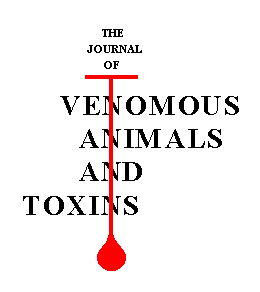THESIS. M. G. Fonseca submitted this for her Doctorate in Tropical Biology publicly examined at the Department of Tropical Medicine and Imaging Diagnosis, Botucatu School of Medicine, UNESP, Botucatu, Brazil, 2000.
Advisor. Prof. Dr. Benedito Barraviera
ABSTRACT. The objective of this study was to evaluate local tissue alterations caused by snake envenoming in relation to the lesion type, affected tissues, and the real extent of the lesions. Fifteen patients bitten by Bothrops snakes and 6 by Crotalus were evaluated. The patients were treated at the Emergency Unit of Hospital das Clínicas da Faculdade de Medicina de Botucatu, UNESP, SP. This study also included clinical aspects, hematological evaluation, and biochemical serum levels, which was performed on the first day of envenoming and again on patient discharge.
Lesion evaluation by magnetic resonance (MR) was performed after serotherapy. A further MR evaluation was performed if the patient was discharged more than 48 hours after the first evaluation. The images were obtained in spin-echo sequence at the following relaxation times: pre-contrast T1 and T2 and post-contrast T1 in adaxial and coronal slice planes.
The hematological evaluation showed no anemia and moderate leukocytosis, especially in the Crotalus group patients. The evaluation of serum levels of bilirubin, aspartate aminotransferase, alanine aminotransferase, and creatine phosphokinase (CK) showed increases on the first day of envenoming and on discharge, especially in the Crotalus group patients. No major alterations were observed in urea, creatinine, and lactate dehydrogenase levels in both groups. Mucoprotein and C reactive protein levels were increased on the first day and on discharge in the Bothrops group patients.
The MR images of the bitten limbs showed that the main lesions were edema in the Bothrops group patients, and edema associated with hemorrhage in the Crotalus group patients. Edema was characterized by a thickening of the subcutaneous and/or muscular cellular tissue, which was represented by a hyposignal in T1 and hypersignal in T2 in the images.
Hemorrhage was seen as an iso to a hypersignal in T1 and hypersignal in T2. Hemorrhage could be seen as discrete bands or large areas of muscular and perimuscular tissues. In the subcutaneous tissue, hemorrhage was seen as a generally discrete liquid accumulation.
Local lesions were not uniformly distributed in the Bothrops group patients. The perimuscular areas in the Bothrops group patients and the muscular tissue in the Crotalus group patients were more affected. The muscular lesions were always accompanied by lesions in the subcutaneous tissue. The muscular lesions were large in both groups, especially in Bothrops group patients, in which they were related to the use of tourniquet and delayed treatment.
Comparison between local tissue lesions evaluated by MR and CK levels showed increases in both groups, regardless of the presence of muscular lesions, suggesting that these contributed little to the elevation of this enzyme level in the plasma.
In this study, the MR evaluation of the lesions in the bitten limb highlighted the following: mionecrosis could not be seen; there was a low incidence of local tissue hemorrhage in the Bothrops group patients; and an important local alteration was observed, especially in the muscular tissues of the Crotalus group patients.
KEY WORDS: Bothrops, Crotalus, magnetic resonance, snake envenoming, creatinine phosphokinase, myonecrosis.
CORRESPONDENCE TO:
M. G. FONSECA - Rua Bartolomeu Bueno Filho, 405, Jardim Paulista, CEP 15060-230, São José do Rio Preto, São Paulo, Brasil.
E-mail: marilucefonseca@hotmail.com

 Tissue lesions in patients bitten by Bothrops and Crotalus snakes: clinical, laboratory, and magnetic resonance evaluations
Tissue lesions in patients bitten by Bothrops and Crotalus snakes: clinical, laboratory, and magnetic resonance evaluations

